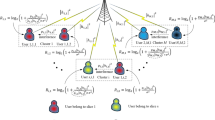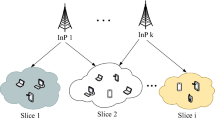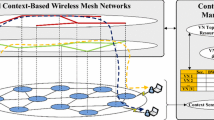Abstract
With the increasing demand for mobile Internet access, WLAN virtualization is becoming a promising solution for sharing wireless infrastructure among multiple service providers. Unfortunately, few mechanisms have been devised to tackle this problem and the existing approaches fail in optimizing the limited bandwidth and providing virtual networks with fairness guarantees. In this paper, we propose a novel algorithm based on control theory to configure the virtual WLANs with the goal of ensuring fairness in the resource distribution, while maximizing the total throughput. Our algorithm works by adapting the contention window configuration of each virtual WLAN to the channel activity in order to ensure optimal operation. We conduct a control-theoretic analysis of our system to appropriately design the parameters of the controller and prove system stability, and undertake an extensive simulation study to show that our proposal optimizes performance under different types of traffic. The results show that the mechanism provides a fair resource distribution independent of the number of stations and their level of activity, and is able to react promptly to changes in the network conditions while ensuring stable operation.









Similar content being viewed by others
Notes
In case of overlapping BSS scenarios, our mechanism can be independently implemented on each AP, as long as they employ appropriate dynamic channel assignment schemes such as, e.g., [11].
Later on we relax this assumption and demonstrate that performance is optimized even when some stations are not saturated.
Although for simplicity reasons we assume throughout the paper a fixed frame length, this assumption could be relaxed following our previous work [13].
Note that this assumption is reasonable, as large values of the transmission probability would lead to high collision probability and hence to an inefficient utilization of the WLAN.
Although in the figure we represent each VAP as a different block, they all run o the same physical device and therefore they can easily share operation parameters, e.g., sniffed frames.
The source code of the simulator used in [13, 16] is available at http://enjambre.it.uc3m.es/~ppatras/owsim/.
References
Janevski T, Tudzarov A, Stojanovski P, Temkov D (2007) Applicative solution for easy introduction of WLAN as value-added service in mobile networks. In: IEEE vehicular technology conference (VTC) spring, pp 1096–1100
Hamaguchi T, Komata T, Nagai T, Shigeno H (2010) A framework of better deployment for WLAN access point using virtualization technique. In: IEEE international conference on advanced information networking and applications workshops (WAINA), pp 968–973
Aljabari G, Eren E (2011) Virtualization of wireless LAN infrastructures. In: IEEE international conference on intelligent data acquisition and advanced computing systems (IDAACS), vol 2, pp 837–841
Xia L, Kumar S, Yang X, Gopalakrishnan P, Liu Y, Schoenberg S, Guo X (2011) Virtual WiFi: bring virtualization from wired to wireless. In: ACM SIGPLAN/SIGOPS international conference on virtual execution environments, ser. VEE ’11. Newport Beach, California, USA, pp 181–192
IEEE 802.11 WG (2007) Information technology—telecommunications and information exchange between systems. Local and metropolitan area networks. Specific requirements. Part 11: Wireless LAN medium access control (MAC) and physical layer (PHY) specifications. IEEE Std 802.11
Berger-Sabbatel G, Duda A, Gaudoin O, Heusse M, Rousseau F (2004) Fairness and its impact on delay in 802.11 networks. In: IEEE global telecommunications conference (GLOBECOM), vol 5, pp 2967–2973
Bhanage G, Vete D, Seskar I, Raychaudhuri D (2010) SplitAP: leveraging wireless network virtualization for flexible sharing of WLANs. In: GLOBECOM 2010, 2010 IEEE global telecommunications conference, pp 1–6
Smith G, Chaturvedi A, Mishra A, Banerjee S (2007) Wireless virtualization on commodity 802.11 hardware. In: ACM international workshop on wireless network testbeds, experimental evaluation and characterization, ser. WinTECH ’07. Montreal, Quebec, Canada, pp 75–82
Perez S, Cabero J, Miguel E (2009) Virtualization of the wireless medium: a simulation-based study. In: IEEE vehicular technology conference (VTC) Spring, pp 1–5
Ahn S-W, Yoo C (2011) Network interface virtualization in wireless communication for multi-streaming service. In: IEEE international symposium on consumer electronics (ISCE), pp 67–70
Akl R, Arepally A (2007) Dynamic channel assignment in IEEE 802.11 networks. In: IEEE international conference on portable information devices (PORTABLE), pp 1–5
Bianchi G (2000) Performance analysis of the IEEE 802.11 distributed coordination function. IEEE J Sel Areas Commun 18(3):535–547
Serrano P, Banchs A, Patras P, Azcorra A (2010) Optimal configuration of 802.11e EDCA for real-time and data traffic. IEEE Trans Veh Technol 59(5):2511–2528
Serrano P, Patras P, Mannocci A, Mancuso V, Banchs A (2012) Control theoretic optimization of 802.11 WLANs: implementation and experimental evaluation. [Online]. Available: http://arxiv.org/abs/1203.2970v1
Banchs A, Vollero L (2006) Throughput analysis and optimal configuration of 802.11e EDCA. Comput Networks 50(11):1749–1768
Patras P, Banchs A, Serrano P, Azcorra A (2011) A control-theoretic approach to distributed optimal configuration of 802.11 WLANs. IEEE Trans Mob Comput 10:897–910
Aström K, Wittenmark B (1990) Computer-controlled systems, theory and design, 2nd edn. Prentice Hall International Editions
Hollot C, Misra V, Towsley D, Gong W-B (2001) A control theoretic analysis of RED. In: Proceedings of IEEE INFOCOM 2001. Anchorage, Alaska
Grieco L, Boggia G, Mascolo S, Camarda P (2003)A control theoretic approach for supporting quality of service in IEEE 802.11e WLANs with HCF. In: IEEE conference on decision and control, vol 2, pp 1586–1591
Franklin GF, Powell JD, Workman ML (1990) Digital control of dynamic systems, 2nd edn. Addison-Wesley
IEEE 802.11 (1999) Supplement to wireless LAN medium access control and physical layer specifications: high-speed physical layer in the 5 GHz band. IEEE Std 802.11a
Jain R, Chiu DM, Hawe W (1984) A quantitative measure of fairness and discrimination for resource allocation in shared systems. DEC Research Report TR-301
He Y, Fang J, Zhang J, Shen H, Tan K, Zhang Y (2010) MPAP: virtualization architecture for heterogenous wireless APs. SIGCOMM Comput Commun Rev 41:475–476
Yap K-K, Kobayashi M, Sherwood R, Huang T-Y, Chan M, Handigol N, McKeown N (2010) OpenRoads: empowering research in mobile networks. SIGCOMM Comput Commun Rev 40:125–126
Matos R, Sargento S, Hummel K, Hess A, Tutschku K, de Meer H (2011) Context-based wireless mesh networks: a case for network virtualization. Telecommun Syst 1–14
Mahindra R, Bhanage G, Hadjichristofi G, Seskar I, Raychaudhuri D, Zhang Y (2008) Space versus time separation for wireless virtualization on an indoor grid. In: Next generation internet networks (NGI), pp 215–222
Grunenberger Y, Rousseau F (2010) Virtual access points for transparent mobility in wireless LANs. In: IEEE wireless communications and networking conference (WCNC), pp 1–6
Berezin M, Rousseau F, Duda A (2011) Multichannel virtual access points for seamless handoffs in IEEE 802.11 wireless networks. In: IEEE vehicular technology conference (VTC Spring), pp 1–5
Chandra R, Bahl P (2004) MultiNet: connecting to multiple IEEE 802.11 networks using a single wireless card. In: INFOCOM 2004, vol 2
Kandula S, Lin KC-J, Badirkhanli T, Katabi D (2008) FatVAP: aggregating AP backhaul capacity to maximize throughput. In: USENIX symposium on networked systems design and implementation (NSDI), San Francisco, California
Giustiniano D, Goma E, Lopez A, Rodriguez P (2009) WiSwitcher: an efficient client for managing multiple APs. In: SIGCOMM workshop on programmable routers for extensible services of tomorrow (PRESTO). Barcelona, Spain, pp 43–48
Giustiniano D, Goma E, Lopez Toledo A, Dangerfield I, Morillo J, Rodriguez P (2010) Fair WLAN backhaul aggregation. In: ACM international conference on mobile computing and networking (MobiCom). Chicago, Illinois, USA, pp 269–280
Glad T, Ljung L (2000) Control theory: multivariable and nonlinear methods. Taylor & Francis
Acknowledgements
This work has been partly supported by the European Community’s Seventh Framework Programme (FP7-ICT-2009-5) under grant agreement n. 257263 (FLAVIA project), and by the Spanish Government, MICINN, under research grant TIN2010-20136-C03.
Author information
Authors and Affiliations
Corresponding author
Appendix
Appendix
Theorem 1
Given the definition of e i in Eq. 14 , there exists an unique solution to the system defined by e i = 0 ∀ i that satisfies e opt = 0 and e fair,i = 0 ∀ i.
Proof
By subtracting e j from e i we obtain
and therefore, given that e i = 0 ∀ i,j, the above results in S i = S j ∀ i, j, and therefore we have that e fair,i = 0 ∀ i. Furthermore, this results in the following relation (as already expressed in Eq. 6),
which specifies, for a given (n i , n j ) pair, a one-to-one relationship between τ j and τ i ∀ i,j, and therefore we can take e.g. τ 1 as reference. In this way, if we express e opt = 0 as
we have that the rhs of the above equation is a constant between 0 and 1, while the lhs is a decreasing function of τ 1 from 1 to 0. Therefore there exists a unique solution that solves the above equation, thus ensuring also that e opt = 0. □
Theorem 2
The K P and K I relationship specified by Eq. 34 guarantees stability.
Proof
According to [33], we need to check that the following transfer function is stable
Computing the above yields
which can be expressed as
where P(z) is a polynomial and
According to [33], a sufficient condition for stability is that the zeros of the pole polynomial fall within the unit circle. This can be ensured by choosing the coefficients {a 1,a 2} that belong to the stability triangle [17]:
Equation 46 is satisfied as long as K P > K I , while Eq. 48 is satisfied if K I > 0. By operating in Eq. 47 we obtain the relationship \(K_P < -K_H^{-1} + K_I/2\), which combined with the previous relations results in the conditions expressed by Eq. 34. □
Rights and permissions
About this article
Cite this article
Banchs, A., Serrano, P., Patras, P. et al. Providing Throughput and Fairness Guarantees in Virtualized WLANs Through Control Theory. Mobile Netw Appl 17, 435–446 (2012). https://doi.org/10.1007/s11036-012-0382-2
Published:
Issue Date:
DOI: https://doi.org/10.1007/s11036-012-0382-2




